Superior Radiation Resistance of ZrO2-Modified W Composites
Abstract
:1. Introduction
2. Experimental
3. Results and Discussion
3.1. ZrO2 Phase Evolution
3.2. Dislocation Loops Characterization
3.3. Mechanical Behavior
4. Conclusions
- (1)
- The spatial structure of ZrO2 phase after high dpa Au+ irradiation consists of three layers, including the amorphous layer (~8 nm), polycrystallization region (~200 nm) and complete ZrO2 matrix. Meanwhile, the element transition layer width increase from ~2 nm up to ~8 nm, attributing to diffusion aggravation at phase boundaries by radiation.
- (2)
- The average diameter and density of the different Burgers vectors (1/2<111> and <001>) dislocation loops are quantitatively determined in three irradiated samples. With the addition of the ZrO2 precipitate, the total number and size of dislocations significantly decrease, especially 1/2<111> loops. Many more glissile 1/2<111> loops migrate to annihilate around the precipitate interface, with a higher sink strength of 7.8 × 1014 m−2.
- (3)
- Owing to the high density of the precipitate interfaces and grain boundaries, the irradiation hardening effect of the swaged W-1.5ZrO2 composites severely weakened after high dpa Au+ irradiation, resulting in the lowest change in irradiation hardness of 4.52 GPa, which is almost consistent with calculation values.
Author Contributions
Funding
Institutional Review Board Statement
Informed Consent Statement
Data Availability Statement
Acknowledgments
Conflicts of Interest
References
- Knaster, J.; Moeslang, A.; Muroga, T. Materials research for fusion. Nat. Phys. 2016, 12, 424–434. [Google Scholar] [CrossRef]
- Schiller, P. Review of materials selection for fusion reactors. J. Nucl. Mater. 1993, 206, 113–120. [Google Scholar] [CrossRef]
- Zinkle, S.; Snead, L. Designing Radiation Resistance in Materials for Fusion Energy. Annu. Rev. Mater. Res. 2014, 44, 241–267. [Google Scholar] [CrossRef]
- Barabash, V.; Federici, G.; Linke, J.; Wu, C. Material/plasma surface interaction issues following neutron damage. J. Nucl. Mater. 2003, 313–316, 42–51. [Google Scholar] [CrossRef]
- De Temmerman, G.; Hirai, T.; Pitts, R.A. The influence of plasma-surface interaction on the performance of tungsten at the ITER divertor vertical targets. Plasma Phys. Control. Fusion 2018, 60, 044018. [Google Scholar] [CrossRef]
- Li, D.; Xu, W.; Kuan, P.; Li, W.; Lin, Z.; Wang, X.; Zhang, L.; Yu, C.; Li, K.; Hu, L. Spectroscopic and laser properties of Ho3+ doped lanthanum-tungsten-tellurite glass and fiber. Ceram. Int. 2016, 42, 10493–10497. [Google Scholar] [CrossRef]
- Hwang, T.; Fukuda, M.; Nogami, S.; Hasegawa, A.; Usami, H.; Yabuuchi, K.; Ozawa, K.; Tanigawa, H. Effect of self-ion irradiation on hardening and microstructure of tungsten. Nucl. Mater. Energy 2016, 9, 542–548. [Google Scholar] [CrossRef] [Green Version]
- Dash, T.; Nayak, B.B. Tungsten carbide—Titanium carbide composite preparation by arc plasma melting and its characterization. Ceram. Int. 2018, 45, 48–52. [Google Scholar] [CrossRef]
- Gilbert, M.; Sublet, J.-C. Neutron-induced transmutation effects in W and W-alloys in a fusion environment. Nucl. Fusion 2011, 51, 043005. [Google Scholar] [CrossRef] [Green Version]
- Cottrell, G.A.; Pampin, R.; Taylor, N.P. Transmutation and Phase Stability of Tungsten Armor in Fusion Power Plants. Fusion Sci. Technol. 2006, 50, 89–98. [Google Scholar] [CrossRef]
- Shkir, M.; Kilany, M.; Yahia, I. Facile microwave-assisted synthesis of tungsten-doped hydroxyapatite nanorods: A systematic structural, morphological, dielectric, radiation and microbial activity studies. Ceram. Int. 2017, 43, 14923–14931. [Google Scholar] [CrossRef]
- Tian, B.; Yu, Q.; Zhang, Z.; Du, Z.; Ren, W.; Shi, P.; Jiang, Z. Effect of magnetron sputtering parameters on adhesion properties of tungsten-rhenium thin film thermocouples. Ceram. Int. 2018, 44, S15–S18. [Google Scholar] [CrossRef]
- Zhao, Z.; Liu, F.; Cao, L.; Du, Y.; Li, B.; Li, J.; Xu, Y. Investigation of indentation response, scratch resistance, and wear behavior of tungsten carbide coatings fabricated by two-step interstitial carburization on tungsten. Ceram. Int. 2021, 47, 30636–30647. [Google Scholar] [CrossRef]
- Dürrschnabel, M.; Klimenkov, M.; Jäntsch, U.; Rieth, M.; Schneider, H.C.; Terentyev, D. New insights into microstructure of neutron-irradiated tungsten. Sci. Rep. 2021, 11, 7572. [Google Scholar] [CrossRef]
- Hwang, T.; Hasegawa, A.; Tomura, K.; Ebisawa, N.; Toyama, T.; Nagai, Y.; Fukuda, M.; Miyazawa, T.; Tanaka, T.; Nogami, S. Effect of neutron irradiation on rhenium cluster formation in tungsten and tungsten-rhenium alloys. J. Nucl. Mater. 2018, 507, 237–239. [Google Scholar] [CrossRef]
- Khantha, M.; Vitek, V.; Pope, D.P. Strain-Rate Dependence of the Brittle-to-Ductile Transition Temperature in TiAl. MRS Proc. 2000, 646, 112–116. [Google Scholar] [CrossRef] [Green Version]
- El-Atwani, O.; Esquivel, E.; Efe, M.; Aydogan, E.; Wang, Y.; Martinez, E.; Maloy, S. Loop and void damage during heavy ion irradiation on nanocrystalline and coarse grained tungsten: Microstructure, effect of dpa rate, temperature, and grain size. Acta Mater. 2018, 149, 206–219. [Google Scholar] [CrossRef]
- Zheng, R.-Y.; Han, W.-Z. Comparative study of radiation defects in ion irradiated bulk and thin-foil tungsten. Acta Mater. 2020, 186, 162–171. [Google Scholar] [CrossRef]
- Yi, X.; Jenkins, M.L.; Kirk, M.A.; Zhou, Z.; Roberts, S.G. In-situ TEM studies of 150 keV W+ ion irradiated W and W-alloys: Damage production and microstructural evolution. Acta Mater. 2016, 112, 105–120. [Google Scholar] [CrossRef] [Green Version]
- Yi, X.; Jenkins, M.L.; Hattar, K.; Edmondson, P.D.; Roberts, S. Characterisation of radiation damage in W and W-based alloys from 2 MeV self-ion near-bulk implantations. Acta Mater. 2015, 92, 163–177. [Google Scholar] [CrossRef] [Green Version]
- El-Atwani, O.; Efe, M.; Heim, B.; Allain, J.P. Surface damage in ultrafine and multimodal grained tungsten materials induced by low energy helium irradiation. J. Nucl. Mater. 2013, 434, 170–177. [Google Scholar] [CrossRef]
- El-Atwani, O.; Gonderman, S.; Suslov, S.; Efe, M.; De Temmerman, G.; Morgan, T.; Bystrov, K.; Hattar, K.; Allain, J.P. Early stage damage of ultrafine-grained tungsten materials exposed to low energy helium ion irradiation. Fusion Eng. Des. 2015, 93, 45–48. [Google Scholar] [CrossRef] [Green Version]
- Giannattasio, A.; Roberts, S. Strain-rate dependence of the brittle-to-ductile transition temperature in tungsten. Philos. Mag. 2007, 87, 123–126. [Google Scholar] [CrossRef] [Green Version]
- Klopp, W.D. A review of chromium, molybdenum, and tungsten alloys. J. Less Common Met. 1975, 42, 261–278. [Google Scholar] [CrossRef]
- Ipatova, I.; Harrison, R.; Wady, P.; Shubeita, S.; Terentyev, D.; Donnelly, S.; Jimenez-Melero, E. Structural defect accumulation in tungsten and tungsten-5wt.% tantalum under incremental proton damage. J. Nucl. Mater. 2018, 501, 329–335. [Google Scholar] [CrossRef]
- Yi, M.; Jing, G.; Li, D.; Xiao, G.; Chen, Z.; Zhang, J.; Wang, L.; Xu, C. Strengthening and toughening mechanism of (W,Ti,Ta)C based cermet with the addition of c-BN@Al2O3. Ceram. Int. 2021, 47, 32075–32085. [Google Scholar] [CrossRef]
- Yari, S.; Dehghanian, C. Deposition and characterization of nanocrystalline and amorphous Ni–W coatings with embedded alumina nanoparticles. Ceram. Int. 2013, 39, 7759–7766. [Google Scholar] [CrossRef]
- Nguyen, B.N.; Henager, C.H.; Wang, J.; Setyawan, W. Tailoring Ductile-Phase Toughened Tungsten Hierarchical Microstructures for Plasma-Facing Materials. J. Nucl. Mater. 2020, 540, 152382. [Google Scholar] [CrossRef]
- Zhao, M.; Issa, I.; Pfeifenberger, M.J.; Wurmshuber, M.; Kiener, D. Tailoring ultra-strong nanocrystalline tungsten nanofoams by reverse phase dissolution. Acta Mater. 2020, 182, 215–225. [Google Scholar] [CrossRef]
- Haag, J.V.; Edwards, D.J.; Henager, C.H.; Setyawan, W.; Wang, J.; Murayama, M. Characterization of ductile phase toughening mechanisms in a hot-rolled tungsten heavy alloy. Acta Mater. 2021, 204, 116523. [Google Scholar] [CrossRef]
- Xie, Z.; Liu, R.; Zhang, T.; Fang, Q.; Liu, C.; Liu, X.; Luo, G. Achieving high strength/ductility in bulk W-Zr-Y2O3 alloy plate with hybrid microstructure. Mater. Des. 2016, 107, 144–152. [Google Scholar] [CrossRef]
- Rieth, M.; Dafferner, B. Limitations of W and W–1%La2O3 for use as structural materials. J. Nucl. Mater. 2005, 342, 20–25. [Google Scholar] [CrossRef]
- Kitsunai, Y.; Kurishita, H.; Kayano, H.; Hiraoka, Y.; Igarashi, T.; Takida, T. Microstructure and impact properties of ultra-fine grained tungsten alloys dispersed with TiC. J. Nucl. Mater. 1999, 271–272, 423–428. [Google Scholar] [CrossRef]
- Wang, S.; Fan, X.; Yang, X.; Zhang, Q.; Wu, K.; Li, D. Feasibility of ZrC-W composite used as a tool of friction stir welding: First principles calculations and experiment. Ceram. Int. 2018, 44, 18650–18655. [Google Scholar] [CrossRef]
- Zhang, J.; Mei, G.; Xie, Z.; Zhao, S. Corrosion mechanism of Mo-W-ZrO2 cermet in molten steel. Ceram. Int. 2018, 44, 8605–8611. [Google Scholar] [CrossRef]
- Bowkett, K.M.; Ralph, B. The annealing of radiation damage in tungsten investigated by field-ion microscopy. Proc. R. Soc. A Math. Phys. Eng. Sci. 1969, 312, 51–63. [Google Scholar]
- Keys, L.; Moteff, J. Neutron irradiation and defect recovery of tungsten. J. Nucl. Mater. 1970, 34, 260–280. [Google Scholar] [CrossRef]
- Was, G.S. Fundamentals of Radiation Materials Science; Springer: Berlin/Heidelberg, Germany, 2017; pp. 329–341. [Google Scholar]
- Yi, X.; Tuo, H.W.; Liu, P.P.; Ferroni, F.; Wan, R.F. Defect Production, Evolution and Thermal Recovery Mechanisms in Radiation Damaged Tungsten. Acta Metall. Sin. 2020, 57, 257–271. [Google Scholar]
- Lu, C.; Lu, Z.; Wang, X.; Xie, R.; Li, Z.; Higgins, M.; Liu, C.; Gao, F.; Wang, L. Enhanced Radiation-tolerant Oxide Dispersion Strengthened Steel and its Microstructure Evolution under Helium-implantation and Heavy-ion Irradiation. Sci. Rep. 2017, 7, 40343. [Google Scholar] [CrossRef] [Green Version]
- Sun, C.; Bufford, D.; Chen, Y.; Kirk, M.A.; Wang, Y.Q.; Li, M.; Wang, H.; Maloy, S.; Zhang, X. In situ study of defect migration kinetics in nanoporous Ag with enhanced radiation tolerance. Sci. Rep. 2014, 4, 3737–3742. [Google Scholar] [CrossRef] [Green Version]
- Nix, W.D.; Gao, H. Indentation size effects in crystalline materials: A law for strain gradient plasticity. J. Mech. Phys. Solids 1998, 46, 411–425. [Google Scholar] [CrossRef]
- Takayama, Y.; Kasada, R.; Yabuuchi, K.; Kimura, A.; Hamaguchi, D.; Ando, M.; Tanigawa, H. Evaluation of Irradiation Hardening of Fe-Ion Irradiated F82H by Nano-Indentation Techniques. J. Nucl. Mater. 2013, 442, S23–S27. [Google Scholar] [CrossRef]
- Zhu, P.; Zhao, Y.; Agarwal, S.; Henry, J.; Zinkle, S.J. Toward accurate evaluation of bulk hardness from nanoindentation testing at low indent depths. Mater. Des. 2022, 213, 110317. [Google Scholar] [CrossRef]
- Queyreau, S.; Monnet, G.; Devincre, B. Orowan strengthening and forest hardening superposition examined by dislocation dynamics simulations. Acta Mater. 2010, 58, 5586–5595. [Google Scholar] [CrossRef]
- El-Atwani, O.; Weaver, J.S.; Esquivel, E.; Efe, M.; Chancey, M.R.; Wang, Y.Q.; Maloy, S.A.; Mara, N. Nanohardness measurements of heavy ion irradiated coarse- and nanocrystalline-grained tungsten at room and high temperature. J. Nucl. Mater. 2018, 509, 276–284. [Google Scholar] [CrossRef]

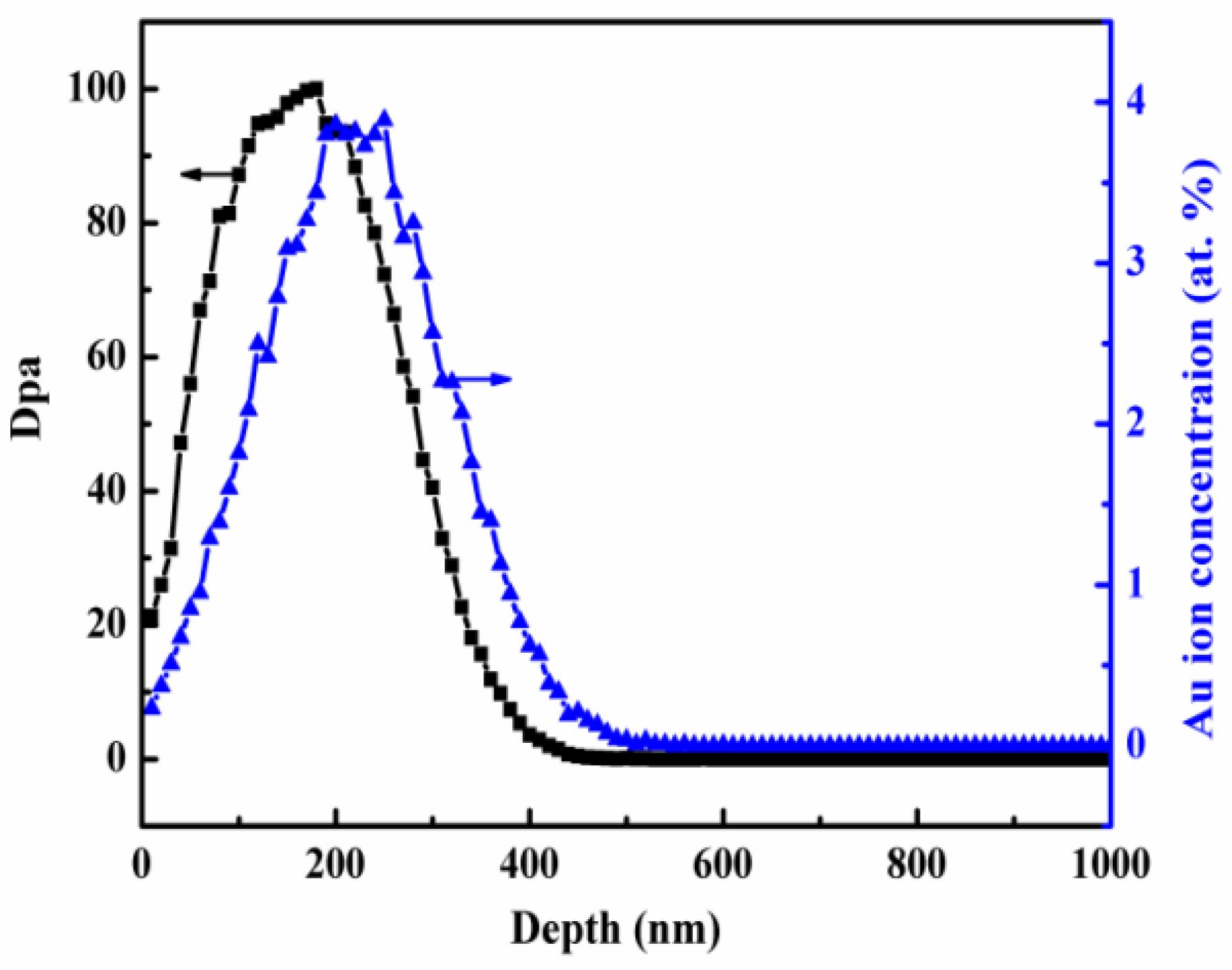
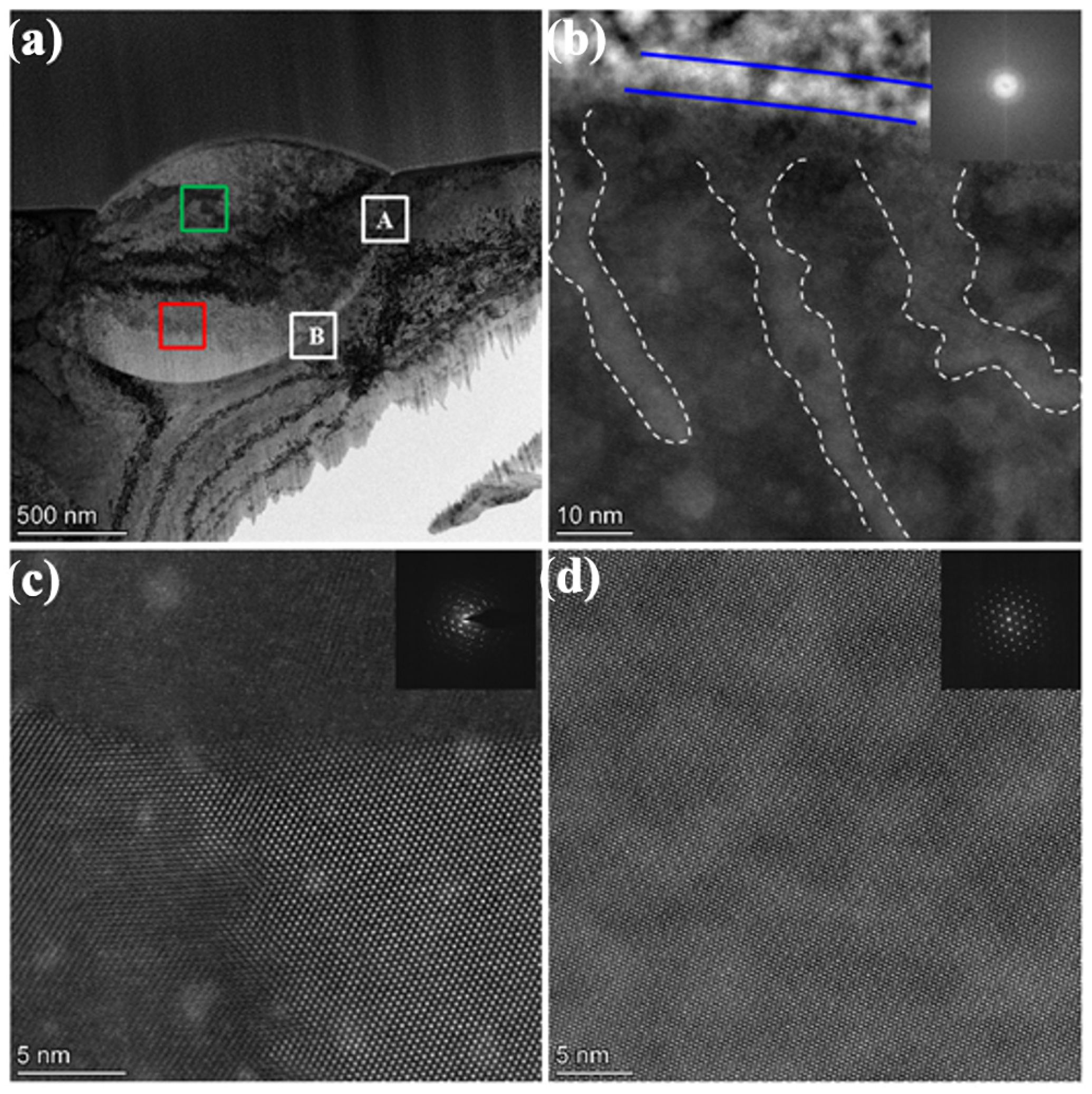
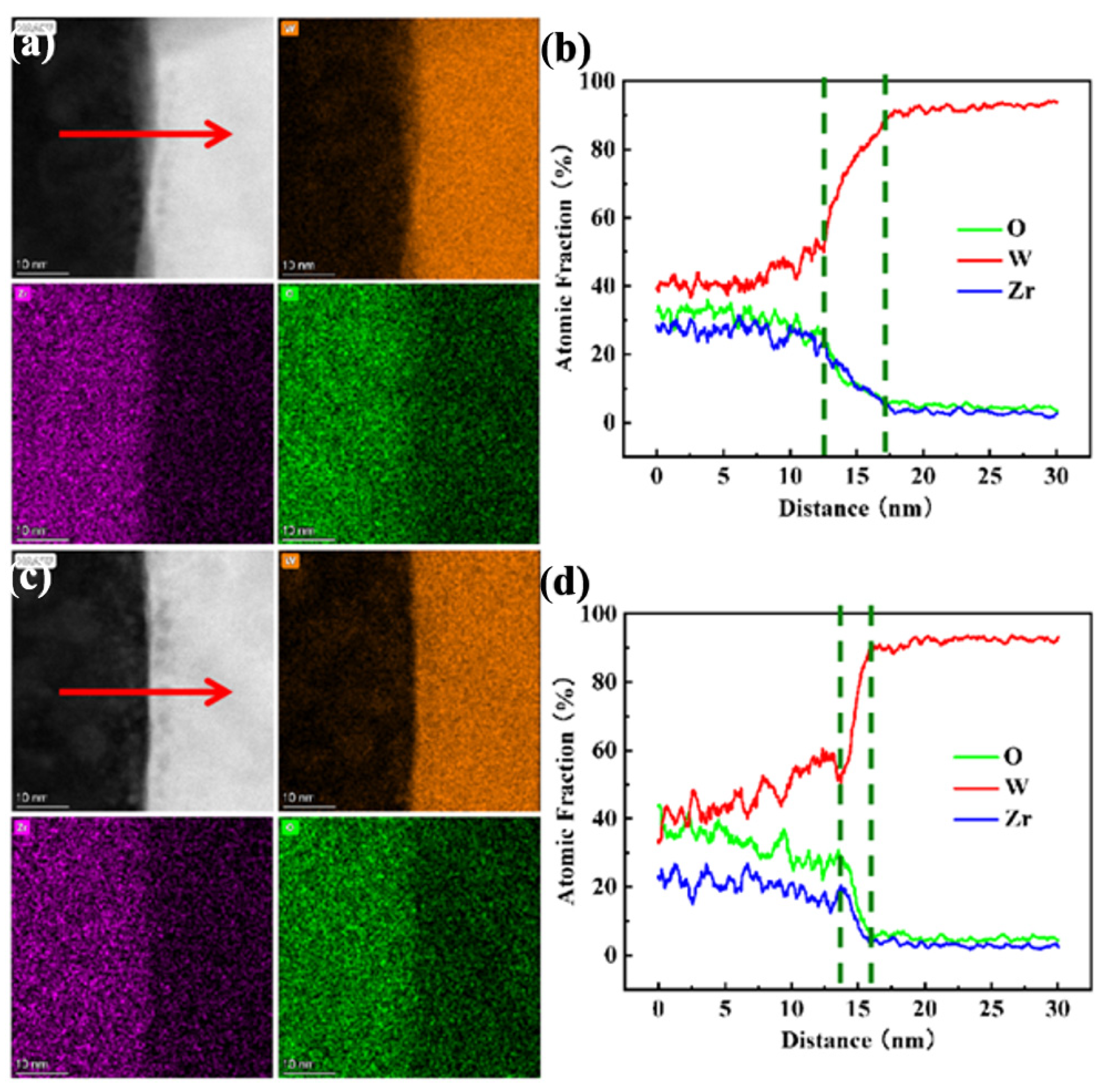

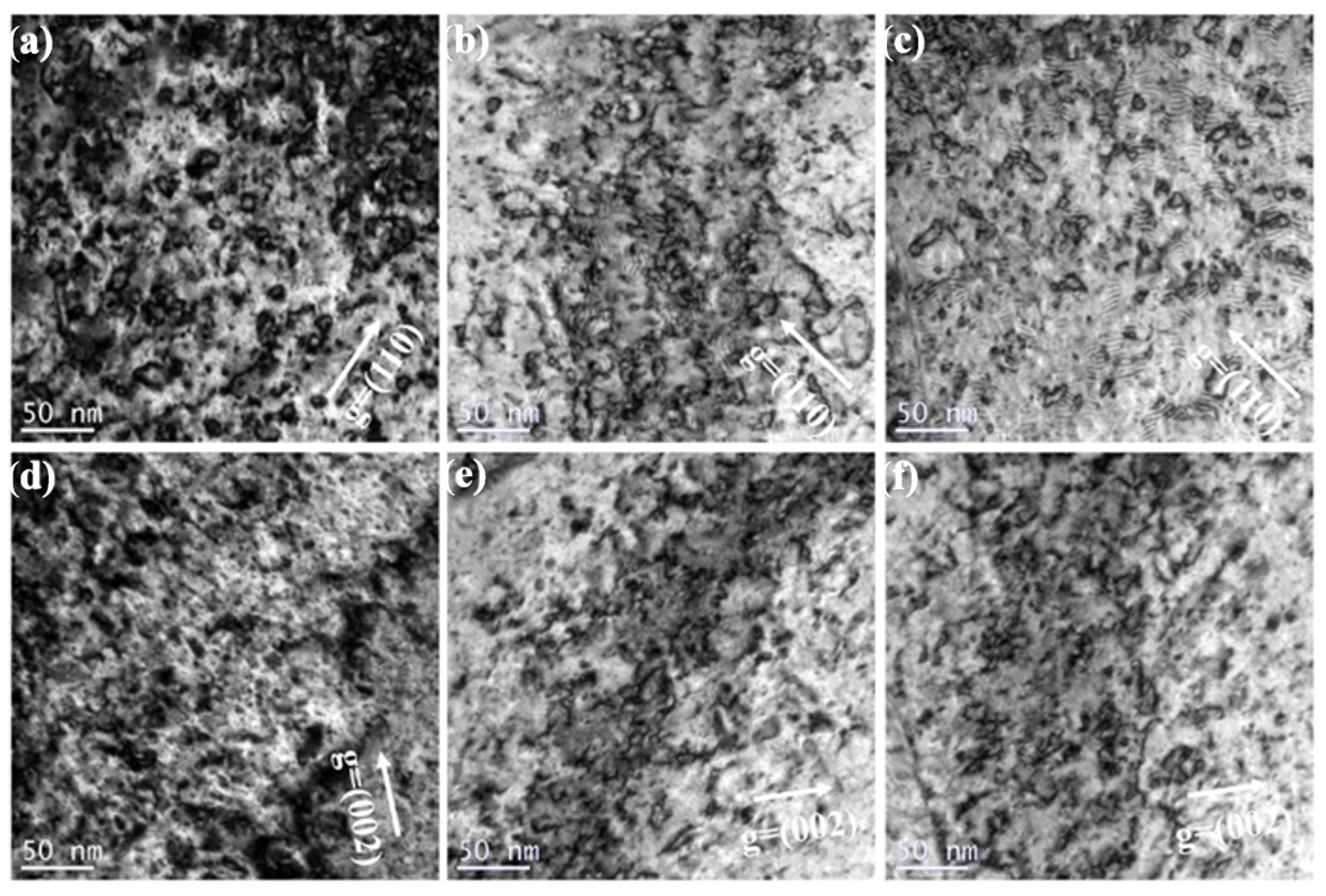
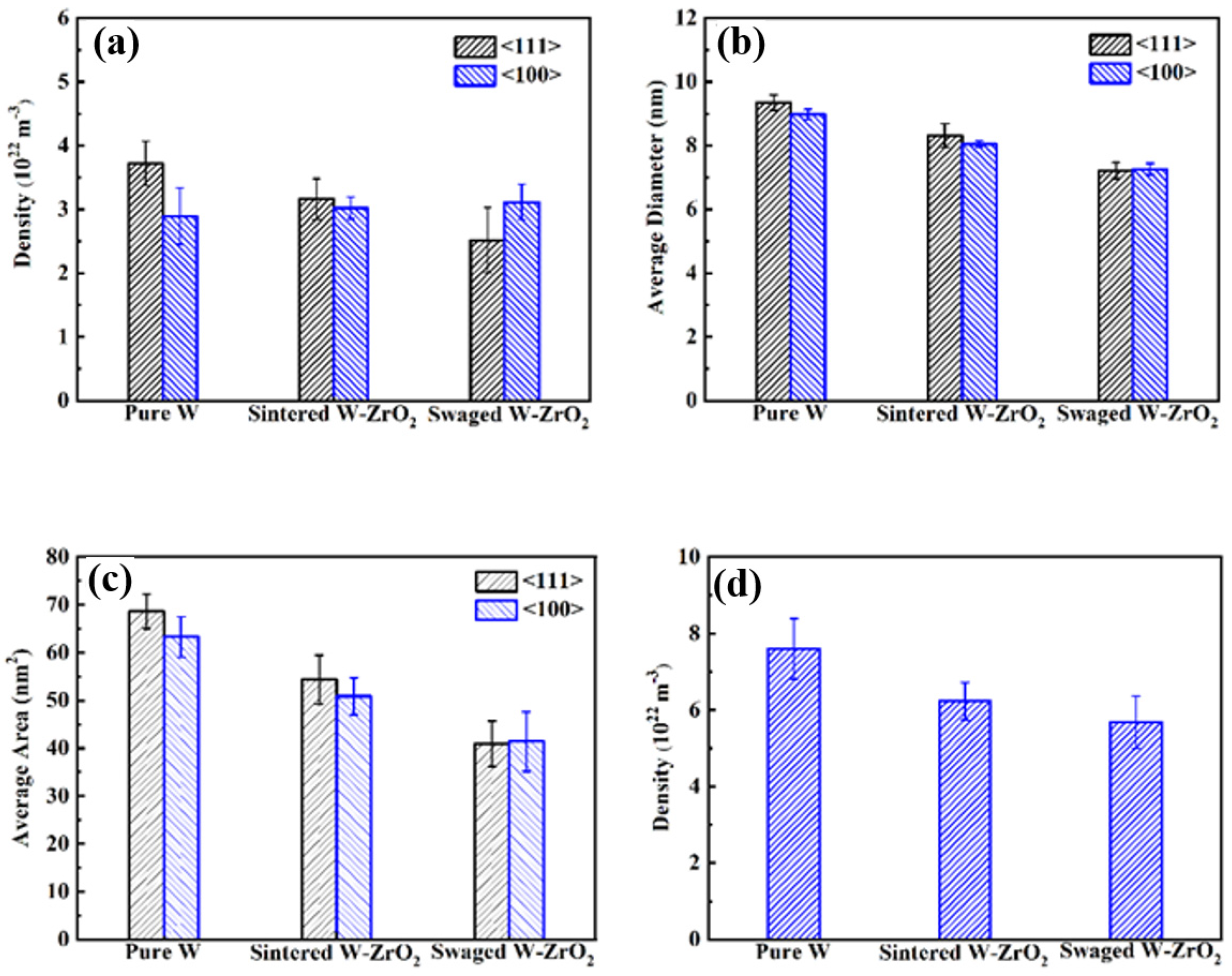


| Samples | ||
|---|---|---|
| Pure W | 9.49 | 8.67 |
| Sintered W-1.5ZrO2 | 6.32 | 5.54 |
| Swaged W-1.5ZrO2 | 5.09 | 4.52 |
Publisher’s Note: MDPI stays neutral with regard to jurisdictional claims in published maps and institutional affiliations. |
© 2022 by the authors. Licensee MDPI, Basel, Switzerland. This article is an open access article distributed under the terms and conditions of the Creative Commons Attribution (CC BY) license (https://creativecommons.org/licenses/by/4.0/).
Share and Cite
Cui, B.; Luo, C.; Chen, X.; Zou, C.; Li, M.; Xu, L.; Yang, J.; Meng, X.; Zhang, H.; Zhou, X.; et al. Superior Radiation Resistance of ZrO2-Modified W Composites. Materials 2022, 15, 1985. https://doi.org/10.3390/ma15061985
Cui B, Luo C, Chen X, Zou C, Li M, Xu L, Yang J, Meng X, Zhang H, Zhou X, et al. Superior Radiation Resistance of ZrO2-Modified W Composites. Materials. 2022; 15(6):1985. https://doi.org/10.3390/ma15061985
Chicago/Turabian StyleCui, Bo, Chunyang Luo, Xiaoxi Chen, Chengqin Zou, Muhong Li, Liujie Xu, Jijun Yang, Xianfu Meng, Haibin Zhang, Xiaosong Zhou, and et al. 2022. "Superior Radiation Resistance of ZrO2-Modified W Composites" Materials 15, no. 6: 1985. https://doi.org/10.3390/ma15061985
APA StyleCui, B., Luo, C., Chen, X., Zou, C., Li, M., Xu, L., Yang, J., Meng, X., Zhang, H., Zhou, X., Peng, S., & Shen, H. (2022). Superior Radiation Resistance of ZrO2-Modified W Composites. Materials, 15(6), 1985. https://doi.org/10.3390/ma15061985






